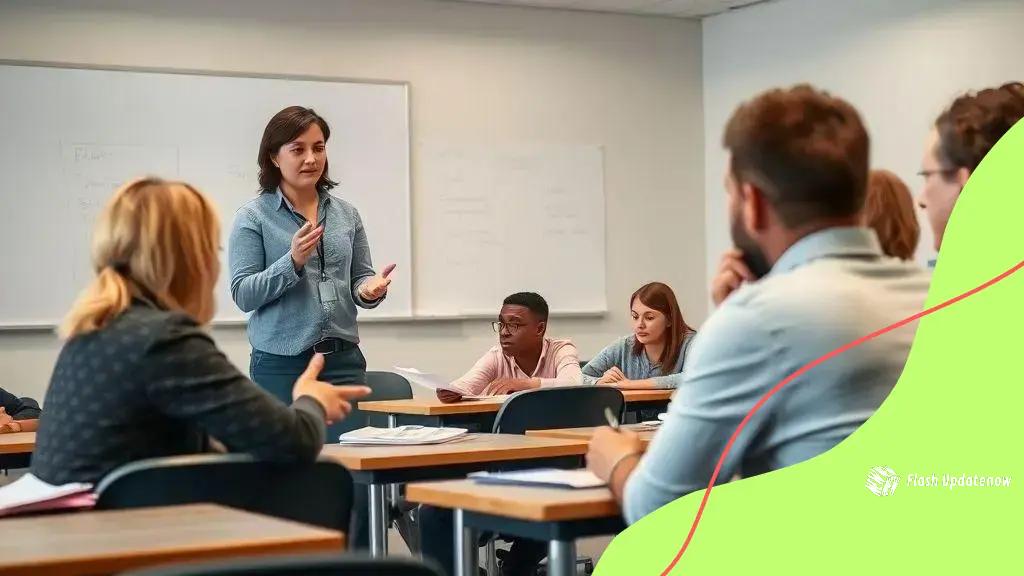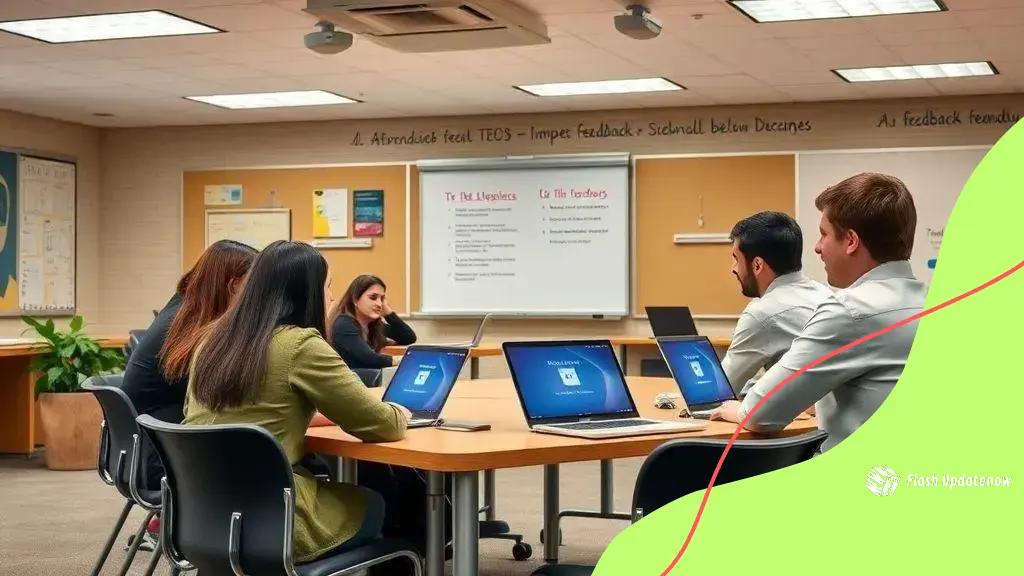Teacher-student feedback loop: unlocking student potential

The teacher-student feedback loop is essential for enhancing learning outcomes, as it fosters communication that allows for constructive feedback, engagement, and improvement in student performance.
Teacher-student feedback loop is essential for fostering an engaging learning atmosphere. Have you ever wondered how powerful effective feedback can be in a student’s educational journey? This article explores its significance and practical application in the classroom.
Understanding the teacher-student feedback loop
Understanding the teacher-student feedback loop is crucial for enhancing learning experiences. This concept revolves around the ongoing communication between teachers and students, where feedback plays a vital role in improving performance and engagement.
At its core, the feedback loop promotes a continuous exchange. Teachers give feedback on assignments, behaviors, and understanding. In turn, students have the opportunity to reflect on this feedback and ask questions. Such interaction not only clarifies expectations but also fosters a deeper understanding of academic material.
Key Elements of the Feedback Loop
This loop has several vital components that contribute to its effectiveness:
- Communication: Clear and open lines of communication encourage questions and discussion.
- Timeliness: Feedback should be provided in a timely manner to be relevant and useful.
- Specificity: The more specific feedback is, the easier it is for students to apply it to their work.
- Reflection: Students should also be encouraged to reflect on the feedback received to foster growth.
By integrating these elements, the teacher-student feedback loop allows for a supportive learning environment. When students receive consistent and constructive feedback, they are more motivated to improve. Moreover, they begin to view challenges as opportunities to learn rather than as obstacles to success.
As students interact with the feedback, they can develop critical thinking skills. This process encourages them to analyze their mistakes and understand their learning paths. Such insight can lead to better academic outcomes and a love for learning. Ultimately, a robust teacher-student feedback loop not only benefits students but also enriches the teaching experience, creating a dynamic and engaging ecosystem for both parties.
Benefits of effective feedback in education
The benefits of effective feedback in education are numerous and significant. Feedback acts as a guiding light, leading students towards their academic goals. When feedback is constructive and timely, it can dramatically enhance a student’s learning experience.
One major benefit is improved understanding. When teachers provide clear and specific feedback, students can identify their strengths and weaknesses. This insight helps them focus on areas that need improvement. Additionally, effective feedback boosts student confidence. As students grasp new concepts and see their progress, they become more motivated to engage with the material.
Positive Impact on Learning
Moreover, feedback fosters a growth mindset. Students learn that their abilities can improve with effort and feedback. This perspective encourages persistence and resilience. Feedback also promotes active learning. When students reflect on the feedback they receive, they’re more likely to engage deeply with the content, leading to better retention of information.
- Encouragement of self-reflection: Effective feedback encourages students to think critically about their work.
- Increased parent engagement: Parents are more informed about their child’s progress when feedback is communicated regularly.
- Better teacher-student relationships: Regular feedback builds trust and respect, making it easier for students to approach teachers with questions.
- Targeted teaching strategies: Teachers can adjust their methods based on the feedback they gather from student performance.
Incorporating feedback into the educational process not only helps students academically but also builds valuable life skills. The ability to accept criticism and use it constructively is essential for personal growth. This two-way communication enhances the learning environment, making it more dynamic and responsive to student needs.
How to create a feedback-friendly classroom environment

Creating a feedback-friendly classroom environment is essential for fostering an engaging learning experience. When students feel comfortable providing and receiving feedback, their learning improves significantly.
One way to encourage this environment is by establishing clear expectations. Teachers should communicate the importance of feedback right from the start. Setting guidelines helps students understand how to give and receive feedback constructively. Regularly discussing these norms reinforces their significance.
Encouraging Open Communication
Open communication is another key factor. Students should feel safe to express their thoughts and ask questions. Creating a routine where sharing feedback is normal encourages students to participate actively. Teachers can model this behavior by sharing their own feedback with the class.
- Collaborative activities: Incorporate group work that requires peer feedback to build trust and openness.
- Feedback sessions: Schedule regular times for students to reflect on their work and discuss feedback with peers.
- Anonymous feedback options: Provide opportunities for students to give feedback anonymously, which can help those who may feel shy to voice their opinions.
- Positive reinforcement: Celebrate instances of good feedback to motivate students to engage in providing constructive criticism.
Moreover, a well-structured physical environment plays a role. Arrange seating to facilitate group discussions. Make sure that students can easily see each other and the teacher during feedback sessions. Creating a dedicated space for discussions can also help in making feedback feel more approachable.
Integrating technology can enhance a feedback-friendly environment as well. Tools like online surveys and collaborative platforms allow students to give and receive feedback outside traditional classroom settings. This can make feedback more relevant and immediate, encouraging a culture of continuous improvement.
Strategies for implementing feedback mechanisms
Implementing effective feedback mechanisms is a crucial aspect of creating an educational environment that fosters learning and growth. Various strategies can be utilized to facilitate this process effectively.
One key method is frequent check-ins. Regularly asking students how they feel about their learning can provide valuable insights. These check-ins can be done through informal conversations or structured surveys. Incorporating student feedback into lesson adjustments demonstrates that their opinions are valued.
Using Technology to Enhance Feedback
Technology can play a significant role in feedback mechanisms. Utilizing learning management systems allows teachers to provide timely feedback on assignments. Online platforms can also enable peer reviews where students can give feedback to one another. This process not only builds critical thinking skills but also fosters collaboration.
- Anonymous online surveys: These tools can gather honest feedback from students who may feel shy sharing their thoughts openly.
- Feedback rubrics: Clearly defined rubrics help students understand assessment criteria, making their feedback more focused and targeted.
- Digital portfolios: Encourage students to track their progress over time, allowing for self-reflection based on feedback.
- Instant messaging apps: Use these for real-time feedback during group projects or discussions, enhancing collaboration.
Creating a cycle of feedback is also beneficial. This involves setting up an ongoing loop where feedback is regularly given, and students respond with their thoughts on the feedback provided. This two-way communication strengthens understanding and ensures that learning objectives are met efficiently.
Moreover, training students on how to give and receive feedback effectively is essential. Teaching them to use constructive language can improve the quality of feedback and make it more actionable. This educational approach not only helps them academically but also develops their interpersonal skills.
Measuring the impact of feedback on student success
Measuring the impact of feedback on student success is vital to understanding how it influences learning outcomes. Various methods can be employed to assess this impact effectively.
One effective approach is through student performance metrics. Analyzing grades and test scores before and after feedback is provided can highlight changes attributable to the feedback process. These metrics can reveal patterns, enabling educators to tailor their feedback strategies to meet individual needs.
Utilizing Surveys and Self-Assessment
Additionally, surveys can be an excellent tool for gathering student perceptions of feedback. Creating questionnaires that ask students how they feel feedback has aided their understanding can offer valuable insights. This subjective data can complement quantitative data, painting a fuller picture of feedback effectiveness.
- Pre- and post-assessments: Administer tests before and after providing feedback to gauge improvement in understanding.
- Feedback reflection journals: Encourage students to keep journals where they reflect on the feedback received and its effects on their learning.
- Peer evaluations: Implement peer assessments to measure how feedback from classmates impacts their understanding and performance.
- Engagement tracking: Monitor student participation and engagement during lessons where feedback is emphasized.
Another method to measure the impact is through classroom observations. Teachers can note changes in student behavior and engagement during lessons that emphasize feedback. This qualitative data can highlight the effectiveness of feedback strategies in real-time.
Finally, tracking long-term outcomes, such as graduation rates and post-secondary success, can provide a broader view of how consistent feedback influences overall student achievement. When students routinely receive constructive feedback throughout their education, it often leads to greater self-efficacy and responsibility for their learning.
FAQ – Frequently Asked Questions about the Teacher-Student Feedback Loop
What is a feedback loop in education?
A feedback loop in education involves ongoing communication between teachers and students, where feedback is provided, and students respond to improve learning outcomes.
How can effective feedback help students succeed?
Effective feedback helps students understand their strengths and weaknesses, guiding them to improve their skills and confidence in their learning.
What strategies can teachers use to implement feedback mechanisms?
Teachers can use regular check-ins, technology tools for online feedback, and peer reviews to create effective feedback mechanisms in the classroom.
How can the impact of feedback be measured?
The impact of feedback can be measured through assessment scores, student surveys, classroom observations, and tracking long-term student outcomes.
